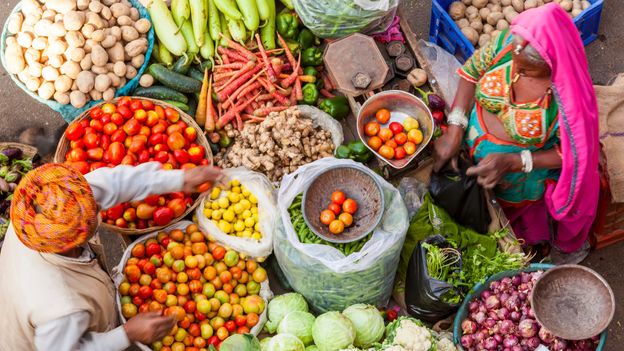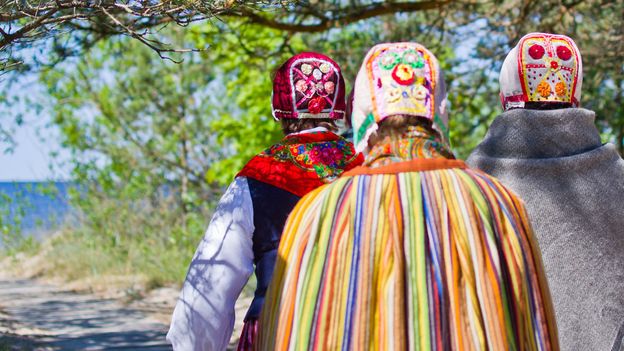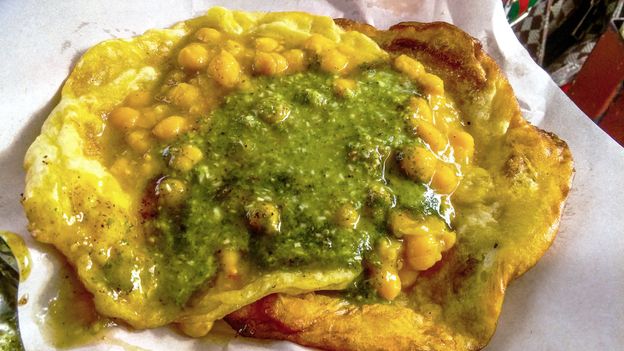According to legend, when the plague came to the city of Yogyakarta on the Indonesian island of Java, the sultan ordered his citizens to cook sayur lodeh and stay home for 49 days. The plague ended. And so began a practice that continues to this day.
Sayur lodeh is a simple vegetable curry made from seven key ingredients and a spicy coconut milk base. Nutritionists that have studied the dish point to the health benefits of additions like galangal, which is thought to have anti-inflammatory qualities. They’ve surmised that such a dish, made from seasonal, easy-to-obtain ingredients, make it perfect for quarantine.
But the most important thing about the sultan’s command to cook sayur lodeh was that it was an appeal to social solidarity. An entire city cooking the same thing at the same time creates a powerful sense of togetherness.
“Like many aspects of Javanese belief, the purpose is to avoid misfortune,” said Revianto Budi Santoso, an architect, teacher and student of Javanese heritage. “Avoiding ominous things is prioritised over individually achieving something. The Javanese think that when there are no obstacles, life looks after itself.”
Javanese food as a whole is rich in symbolism. For instance, nasi tumpeng is a mixture of meat and vegetables crowned by a tower of cone-shaped yellow rice. The presentation of the dish is supposed to mirror the order of the world under God. Nasi kuning is an aromatic yellow rice dish thought to bring blessings to new homes and businesses. And the turmeric drink jamu takes its name from the Javanese word meaning “prayer for health” and is claimed to promote calmness.
Sayur lodeh extends this symbolism linguistically and numerologically. Each of the seven key ingredients that are added to a base of coconut milk – melinjo (an olive-like fruit), melinjo leaf, chayote (a type of squash), long beans, aubergine, jackfruit and tempeh – has a symbolic meaning that is derived from the sound of its syllables.
Like many aspects of Javanese belief, the purpose is to avoid misfortune
In Javanese, the wungu of terong wungu (aubergine) means purple, but also something like “awaken”; while the lanjar of kacang lanjar (green beans) equates to “blessings”. Put together the seven items and you have something approximating a spell.
The ritual of cooking sayur lodeh is an example of a slametan, a type of communal rite that the anthropologist Clifford Geertz identified as a central feature of Javanese culture. One striking characteristic of the slametanis its fatalism; sayur lodeh is performed without much expectation that it will actually work.
“It’s interesting that the sayur lodeh is not an individual thing,” said Santoso. “It’s a response to a misfortune that looks like it will overpower everyone. It’s an effort to mitigate, as much as avoid, something that is probably inevitable.”
For an outsider, one of the attractive things about the magic of the sayur lodeh story is just how unmagical it is. The ingredients are a list of things that any Javanese villager is likely to have to hand. Preparing the dish is simple: you put all the ingredients in a pot, then hang it over a fire. In the past, the cooking would begin after two royal heirlooms – a spear and a sacred flag, supposedly made of material taken from the tomb of the prophet Muhammad – were paraded through the streets. Nowadays, it’s more like a regular meal. Alongside the linguistic and numerological complexity, there’s a practicality, if not deep mundanity, that makes this slamentan appealingly contrary.
You may also be interested in:
• Why no one else speak’s Indonesia’s language
• The suprising truth about Indian food
• Asia’s centuries-old ‘lockdown’ law
While sayur lodeh is straightforward to make, its origins are complex. Some scholars believe the tradition stretches back to central Java’s civilisational heyday in the 10th Century, where lodeh enabled residents to shelter safely during the massive eruption of Mount Merapi in 1006. Food historians such as Fadly Rahman have dated sayur lodeh to the 16th Century after the Spanish and Portuguese introduced long beans to Java. Still others have argued that it is an “ancient tradition” that was invented in the 19th Century: at the turn of the 20th Century, Yogyakarta intellectuals were at the heart of the Indonesian National Awakening, a period when many national myths were variously discovered, celebrated and created.
If nothing else, the sayur lodeh legend was amplified in the early 20th Century. The most famous example comes from 1931 when, during the reign of Sultan HB VIII, Java had been suffering from successive waves of bubonic plague for more than two decades. But records also show that sayur lodeh was cooked to respond to crisis in 1876, 1892, 1946, 1948 and 1951. To make matters even more complicated, over time sayur lodeh has become popular across the entire Malay Archipelago. It quickly becomes difficult to isolate why, when and how the dish evolved.
The food historian Khir Johari believes that such questions are irrelevant.
“When we look at the history of food, the temptation is to try and join dots so that you end up with a monocentric story,” he said, “but there can be multiple centres of creation.”
“The Chinese Peranaken community in Singapore serve sayur lodeh as a kind of yellow vegetable stew that you eat with lontong (compacted rice),” he said, “while Javanese Singaporeans make a white lodeh without turmeric.”
Now Indonesians are beginning to realise the health benefits of our traditional foods
For Johari, the transformation of sayur lodeh as it diffused through the patchwork of cultures that make up the Malay Archipelago illustrates the interplay between food, social customs and environment. While the lush agricultural lands surrounding Yogyakarta supply the vegetables that enable villagers to face plagues and volcanic eruptions, the region is dominated by major maritime nodes where quarantine meant imposing isolation on newly arrived travellers. It seems likely that Javanese sailors were responsible for popularising the dish outside of Yogyakarta: soups, chowders and curries like sayur lodeh become deeply practical when stuck on a ship.
And the dish keeps on evolving. In the hyper-urban South East Asian cities of today, sayur lodeh has been rediscovered as a health food. It’s also become a heritage dish that attracts the attention of a rapidly growing middle class: for the Instagram generation, the rich colours of sayur lodeh lend themselves to comparison, competition and attention-grabbing imagery.
“When I first opened my shop people used to drink jamu for the benefit of social media: ‘Look how in touch I am with my culture’, that sort of thing,” said Nova Dewi Setiabudi who runs the Suwe Ora Jamu cafe in M Bloc, one of Jakarta’s hipster districts. “But now Indonesians are beginning to realise the health benefits of our traditional foods; we don’t always realise the medicinal benefits of ingredients like bay leaves, lemongrass and galangal.”
Outside of Yogyakarta , sayur lodeh may have lost its exact meaning, but it is still recognised as a dish that is somehow about more than just food. “Lodeh is a simple food,” said Nova, “but there is great philosophy – wisdom – behind it. The key is fresh ingredients.”
For now, the changing food fashions of Jakarta have little to do with the popularity of the dish in Yogyakarta. When an instruction to cook sayur lodeh because of Covid-19 was recently shared around the city via WhatsApp groups, purportedly from the current Sultan of Yogyakarta, the majority of residents took it to heart, with people preparing the dish and sharing it with their neighbours. Yogyakarta has been transformed over the last 20 years, with the rapid construction of hotels, malls and a new airport, but the need for rituals and reassurance has remained unchanged. If anything, technological advances in communication have worked to emphasise the continuing primacy of older emotional reflexes.
However, no-one in Yogyakarta is actually sure whether the WhatsApp messages came from the sultan or not. The palace told a local newspaper that it hadn’t, but this denial is not believed by everyone. While Yogyakarta is an anomaly in Indonesia, an autonomous kingdom inside a republic, the current sultan is keen to be seen as a modernising figure and appears to want to distance himself from the superstitions attached to the dish. His reticence to acknowledge the tradition might be explained in terms of political risk: in the context of the current pandemic, public health officials worry that the millions who will likely travel across Indonesia at the end of Ramadan in May might unwittingly carry Covid-19 with them. While confirmed cases in Yogyakarta are still very low, it would not look good if sayur lodeh appeared central to the Sultanate’s response to the crisis.
Yet, while one can sympathise with this logic, that doesn’t mean that local enthusiasm for sayur lodeh is misplaced. The people of Yogyakarta responded to the crisis as they have always done: by cooking sayur lodeh. And it didn’t matter to them whether the command came from the sultan or not. Now they wait 49 days.
Recipe
Preparation time: 15 minutes | Cooking time: 20 minutes | Servings: 4
Ingredients:
50g melinjo
100g melinjo leaf
200g chayote
100g long beans
1 purple aubergine
1 jackfruit
1 piece tempeh
100 ml coconut milk
Spices:
6 shallots
3 cloves of garlic
1 tsp coriander powder
1 tbsp of salt
Sugar to taste
1 red chilli
3 green chilli
1cm galangal
1 bay leaf
Vegetable preparation:
Peel the chayote and cut into cubes
Cut long beans into 2 cm chunks
Cut the aubergine into cubes
Peel and chop the jackfruit
Spice preparation:
Puree garlic, shallots, coriander, salt and sugar
Slice the red chilli and green chilli
How to cook:
Bring the coconut milk to the boil while stirring in the spices
Add the galangal, jackfruit, chayote, melinjo and long beans until cooked
Add melinjo leaves, chilli, aubergine and tempeh until cooked
Culinary Roots is a series from BBC Travel connecting to the rare and local foods woven into a place’s heritage.
Join more than three million BBC Travel fans by liking us on Facebook, or follow us on Twitter and Instagram.
If you liked this story, sign up for the weekly bbc.com features newsletter called “The Essential List”. A handpicked selection of stories from BBC Future, Culture, Worklife and Travel, delivered to your inbox every Friday.



























